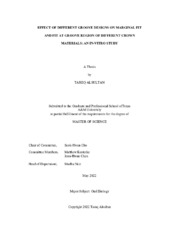| dc.description.abstract | The purpose of this in vitro study was to evaluate the effect of different groove designs on the
internal fit, marginal and fit at the groove region across crown materials using 3D-analysis. A total of 120 samples were used in this study. 3 different restorative materials were evaluated: milled zirconia, pressed emax and printed resin. There were 4 groove designs included in this study: no groove ‘control’, small groove, medium groove and large groove. There were a total of 12 groups and each group consisted of 10 samples.
All samples were designed on an ivorine master maxillary first molar tooth. Zirconia crowns
were milled out of BruxZir 16 blocks. Emax crowns pressed using HT IPS emax press ingots. Resin crowns were printed using Dentca crown and bridge resin material using SprintRay 3D printer. All samples were scanned using Trios 3 intraoral scanner. Marginal fit and fit at groove region were evaluated in Geomajic Control Software (3D systems) using the triple scan technique.
Data were not normally distributed, therefore non-parametric independent sample tests
(Kruskal-Wallis test) were used to check for significant differences between the groups. Significance value was set at α=0.05, and adjusted with Bonferroni correction for multiple tests. Statistical significant differences were found among the zirconia, resin and emax groups when they were evaluated for marginal discrepancy. Fit at mesial region was statistically significantly different among resin and emax groups, however different groove designs had no effect on the fit discrepancy across the zirconia groups.
The results of this study suggests that the introduction of a groove design into a crown
preparation can affect the fit discrepancy (marginal fit and fit at groove area) of the definitive
restoration. CAD/CAM fabricated crowns had better fit across all groups than crowns fabricated
using conventional techniques. | |


